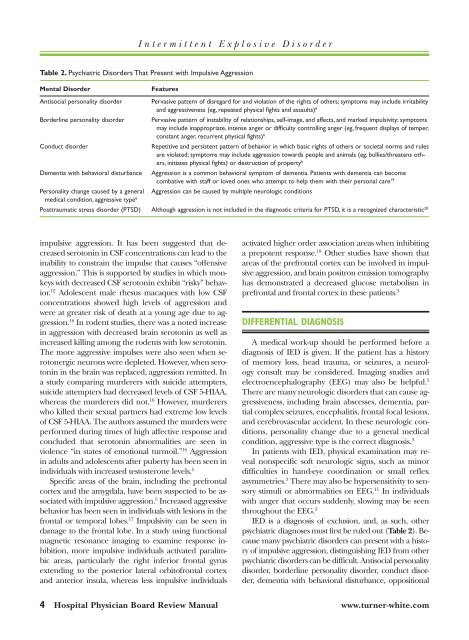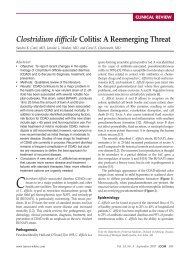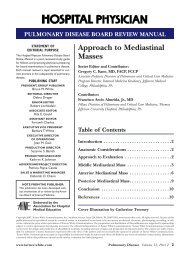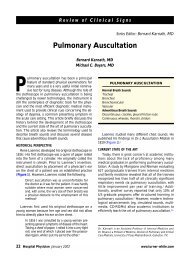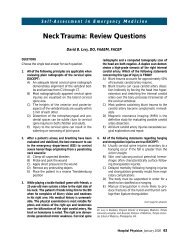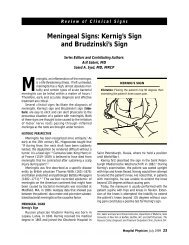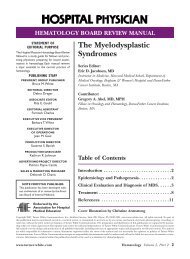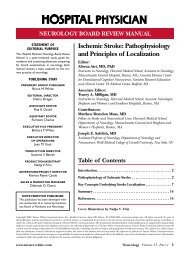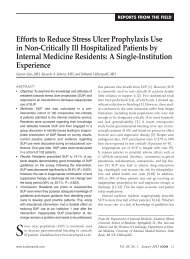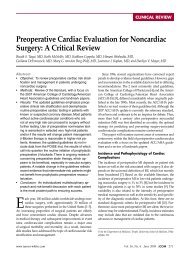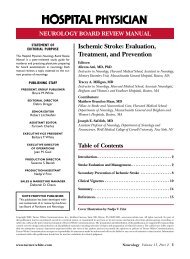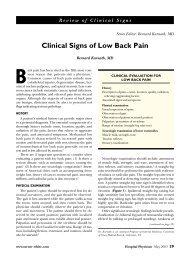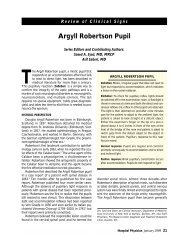Intermittent Explosive Disorder - Turner White
Intermittent Explosive Disorder - Turner White
Intermittent Explosive Disorder - Turner White
You also want an ePaper? Increase the reach of your titles
YUMPU automatically turns print PDFs into web optimized ePapers that Google loves.
I n t e r m i t t e n t E x p l o s i v e D i s o r d e r<br />
Table 2. Psychiatric <strong>Disorder</strong>s That Present with Impulsive Aggression<br />
Mental <strong>Disorder</strong><br />
Features<br />
Antisocial personality disorder<br />
Borderline personality disorder<br />
Conduct disorder<br />
Dementia with behavioral disturbance<br />
Personality change caused by a general<br />
medical condition, aggressive type 6<br />
Pervasive pattern of disregard for and violation of the rights of others; symptoms may include irritability<br />
and aggressiveness (eg, repeated physical fights and assaults) 6<br />
Pervasive pattern of instability of relationships, self-image, and affects, and marked impulsivity; symptoms<br />
may include inappropriate, intense anger or difficulty controlling anger (eg, frequent displays of temper,<br />
constant anger, recurrent physical fights) 6<br />
Repetitive and persistent pattern of behavior in which basic rights of others or societal norms and rules<br />
are violated; symptoms may include aggression towards people and animals (eg, bullies/threatens others,<br />
initiates physical fights) or destruction of property 6<br />
Aggression is a common behavioral symptom of dementia. Patients with dementia can become<br />
combative with staff or loved ones who attempt to help them with their personal care 19<br />
Aggression can be caused by multiple neurologic conditions<br />
Posttraumatic stress disorder (PTSD) Although aggression is not included in the diagnostic criteria for PTSD, it is a recognized characteristic 20<br />
impulsive aggression. It has been suggested that decreased<br />
serotonin in CSF concentrations can lead to the<br />
inability to constrain the impulse that causes “offensive<br />
aggression.” This is supported by studies in which monkeys<br />
with decreased CSF serotonin exhibit “risky” behavior.<br />
12 Adolescent male rhesus macaques with low CSF<br />
concentrations showed high levels of aggression and<br />
were at greater risk of death at a young age due to aggression.<br />
16 In rodent studies, there was a noted increase<br />
in aggression with decreased brain serotonin as well as<br />
increased killing among the rodents with low serotonin.<br />
The more aggressive impulses were also seen when serotonergic<br />
neurons were depleted. However, when serotonin<br />
in the brain was replaced, aggression remitted. In<br />
a study comparing murderers with suicide attempters,<br />
suicide attempters had decreased levels of CSF 5-HIAA,<br />
whereas the murderers did not. 16 However, murderers<br />
who killed their sexual partners had extreme low levels<br />
of CSF 5-HIAA. The authors assumed the murders were<br />
performed during times of high affective response and<br />
concluded that serotonin abnormalities are seen in<br />
violence “in states of emotional turmoil.” 16 Aggression<br />
in adults and adolescents after puberty has been seen in<br />
individuals with increased testosterone levels. 5<br />
Specific areas of the brain, including the prefrontal<br />
cortex and the amygdala, have been suspected to be associated<br />
with impulsive aggression. 5 Increased aggressive<br />
behavior has been seen in individuals with lesions in the<br />
frontal or temporal lobes. 17 Impulsivity can be seen in<br />
damage to the frontal lobe. In a study using functional<br />
magnetic resonance imaging to examine response inhibition,<br />
more impulsive individuals activated paralimbic<br />
areas, particularly the right inferior frontal gyrus<br />
extending to the posterior lateral orbitofrontal cortex<br />
and anterior insula, whereas less impulsive individuals<br />
activated higher order association areas when inhibiting<br />
a prepotent response. 18 Other studies have shown that<br />
areas of the prefrontal cortex can be involved in impulsive<br />
aggression, and brain positron emission tomography<br />
has demonstrated a decreased glucose metabolism in<br />
prefrontal and frontal cortex in these patients. 3<br />
DIFFERENTIAL DIAGNOSIS<br />
A medical work-up should be performed before a<br />
diagnosis of IED is given. If the patient has a history<br />
of memory loss, head trauma, or seizures, a neurology<br />
consult may be considered. Imaging studies and<br />
electroencephalography (EEG) may also be helpful. 5<br />
There are many neurologic disorders that can cause aggressiveness,<br />
including brain abscesses, dementia, partial<br />
complex seizures, encephalitis, frontal focal lesions,<br />
and cerebrovascular accident. In these neurologic conditions,<br />
personality change due to a general medical<br />
condition, aggressive type is the correct diagnosis. 3<br />
In patients with IED, physical examination may reveal<br />
nonspecific soft neurologic signs, such as minor<br />
difficulties in hand-eye coordination or small reflex<br />
asymmetries. 3 There may also be hypersensitivity to sensory<br />
stimuli or abnormalities on EEG. 11 In individuals<br />
with anger that occurs suddenly, slowing may be seen<br />
throughout the EEG. 3<br />
IED is a diagnosis of exclusion, and, as such, other<br />
psychiatric diagnoses must first be ruled out (Table 2). Because<br />
many psychiatric disorders can present with a history<br />
of impulsive aggression, distinguishing IED from other<br />
psychiatric disorders can be difficult. Antisocial personality<br />
disorder, borderline personality disorder, conduct disorder,<br />
dementia with behavioral disturbance, oppositional<br />
Hospital Physician Board Review Manual<br />
www.turner-white.com


